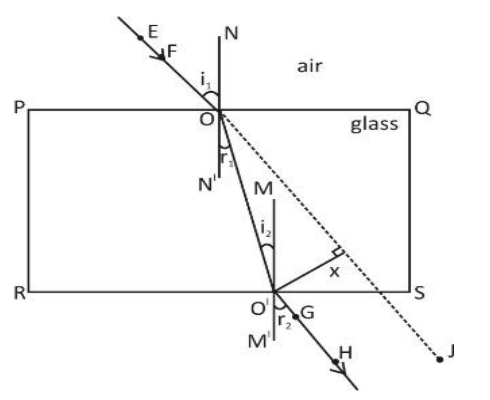
Explain the refraction of light through a glass-slab with a neat ray diagram.
Answer
435.3k+ views
13 likes
Hint: When the light ray travels from rarer to denser medium it bends towards the normal while that of rarer to denser goes away from normal.
Complete step by step solution: Consider a rectangular glass slab PQRS having parallel faces PQ and RS as shown in below figure.

A ray of light EF in air is incident on the glass surface PQ at point O. As the ray EO enters from air (rarer medium) to glass (denser medium), the ray bends towards normal and follows the path
As per the laws of refraction, the emergent ray
Note: When the light ray has incidental in a medium and after this the light ray reflected in different media and then comes out in the same medium as it was incidence then the incident ray and emergent ray are parallel to each other.
Complete step by step solution: Consider a rectangular glass slab PQRS having parallel faces PQ and RS as shown in below figure.

A ray of light EF in air is incident on the glass surface PQ at point O. As the ray EO enters from air (rarer medium) to glass (denser medium), the ray bends towards normal and follows the path
As per the laws of refraction, the emergent ray
Note: When the light ray has incidental in a medium and after this the light ray reflected in different media and then comes out in the same medium as it was incidence then the incident ray and emergent ray are parallel to each other.
Recently Updated Pages
Master Class 11 Economics: Engaging Questions & Answers for Success

Master Class 11 Business Studies: Engaging Questions & Answers for Success

Master Class 11 Accountancy: Engaging Questions & Answers for Success

Questions & Answers - Ask your doubts

Master Class 11 Accountancy: Engaging Questions & Answers for Success

Master Class 11 Science: Engaging Questions & Answers for Success

Trending doubts
A boat goes 24 km upstream and 28 km downstream in class 10 maths CBSE

Why is there a time difference of about 5 hours between class 10 social science CBSE

The Equation xxx + 2 is Satisfied when x is Equal to Class 10 Maths

What is the full form of POSCO class 10 social science CBSE

Change the following sentences into negative and interrogative class 10 english CBSE

How do you prove that the diagonals of a rectangle class 10 maths CBSE




